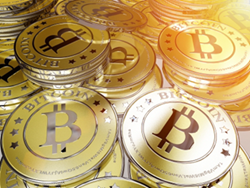Learning objectives: Explain and compare the distinctive risks that Bitcoin presents. Describe the measures taken to regulate virtual currencies.

Questions:
701.1. As a store of value and payment method, Bitcoin presents a distinct set of risks. Each of the following is a risk associated with Bitcoin but which is realistically the LEAST LIKELY risk?
a. Identity risk: the private bitcoin key is only 256 bits which is relatively short, giving hackers a significant possibility of randomly guessing a user's private key
b. Counterparty risk: this has become substantial because exchanges often act as de facto banks, as users convert currency to bitcoin but then leave the bitcoin in the exchange
c. Transaction risk: transactions are irreversible, as bitcoin offers no built-in mechanism to undo errors; and further transactions do not clear until they have been added to the authoritative block chain, with batches only added every ten minutes
d. Privacy risk: bitcoin transactions are pseudonymous (i.e., not truly anonymous) because each transaction specifies the user’s public key, so that a series of user transactions might possibly associated, as an inference, with a specific real person
701.2. The authors note that "the original vision of Bitcoin is broadly in tension with regulation and government control." From a regulatory perspective, in addition to consumer protections, the authors consider the following three classes of Bitcoin-related criminal concerns:
a. The most natural targets for regulators are intermediaries
b. The most natural targets for regulators are peers on the network
c. The most natural mechanism for regulators is country-specific regulations coupled with country-specific currency controls
d. In reality Bitcoin's decentralization makes it impossible to regulate
701.3. Each of the following is true about Bitcoin EXCEPT which statement is not accurate?
a. Blacklists add complexity and risk but would make it easier to regulate the problem of theft
b. Bitcoin's protocol is designed to mitigate the classic cryptocurrency problem of double-spending
c. The Bitcoin economy implements a variant of Milton Friedman's "k-percent rule" which effectively automates monetary policy
d. There is a modest limit to the size of Bitcoin's and the blockchain's market because they are only payments systems, and this market is already efficient and somewhat saturated with credit card and debit card networks
Answers here:

Questions:
701.1. As a store of value and payment method, Bitcoin presents a distinct set of risks. Each of the following is a risk associated with Bitcoin but which is realistically the LEAST LIKELY risk?
a. Identity risk: the private bitcoin key is only 256 bits which is relatively short, giving hackers a significant possibility of randomly guessing a user's private key
b. Counterparty risk: this has become substantial because exchanges often act as de facto banks, as users convert currency to bitcoin but then leave the bitcoin in the exchange
c. Transaction risk: transactions are irreversible, as bitcoin offers no built-in mechanism to undo errors; and further transactions do not clear until they have been added to the authoritative block chain, with batches only added every ten minutes
d. Privacy risk: bitcoin transactions are pseudonymous (i.e., not truly anonymous) because each transaction specifies the user’s public key, so that a series of user transactions might possibly associated, as an inference, with a specific real person
701.2. The authors note that "the original vision of Bitcoin is broadly in tension with regulation and government control." From a regulatory perspective, in addition to consumer protections, the authors consider the following three classes of Bitcoin-related criminal concerns:
- Money-laundering: routing funds through mixers promotes anonymity
- Bitcoin-specific crimes: attacks on the currency and its infrastructure; e.g., bitcoin theft, attacks on mining pools, denial-of-service attacks
- Bitcoin-facilitated crimes: payment for unlawful services delivered offline
a. The most natural targets for regulators are intermediaries
b. The most natural targets for regulators are peers on the network
c. The most natural mechanism for regulators is country-specific regulations coupled with country-specific currency controls
d. In reality Bitcoin's decentralization makes it impossible to regulate
701.3. Each of the following is true about Bitcoin EXCEPT which statement is not accurate?
a. Blacklists add complexity and risk but would make it easier to regulate the problem of theft
b. Bitcoin's protocol is designed to mitigate the classic cryptocurrency problem of double-spending
c. The Bitcoin economy implements a variant of Milton Friedman's "k-percent rule" which effectively automates monetary policy
d. There is a modest limit to the size of Bitcoin's and the blockchain's market because they are only payments systems, and this market is already efficient and somewhat saturated with credit card and debit card networks
Answers here:
Last edited by a moderator:
